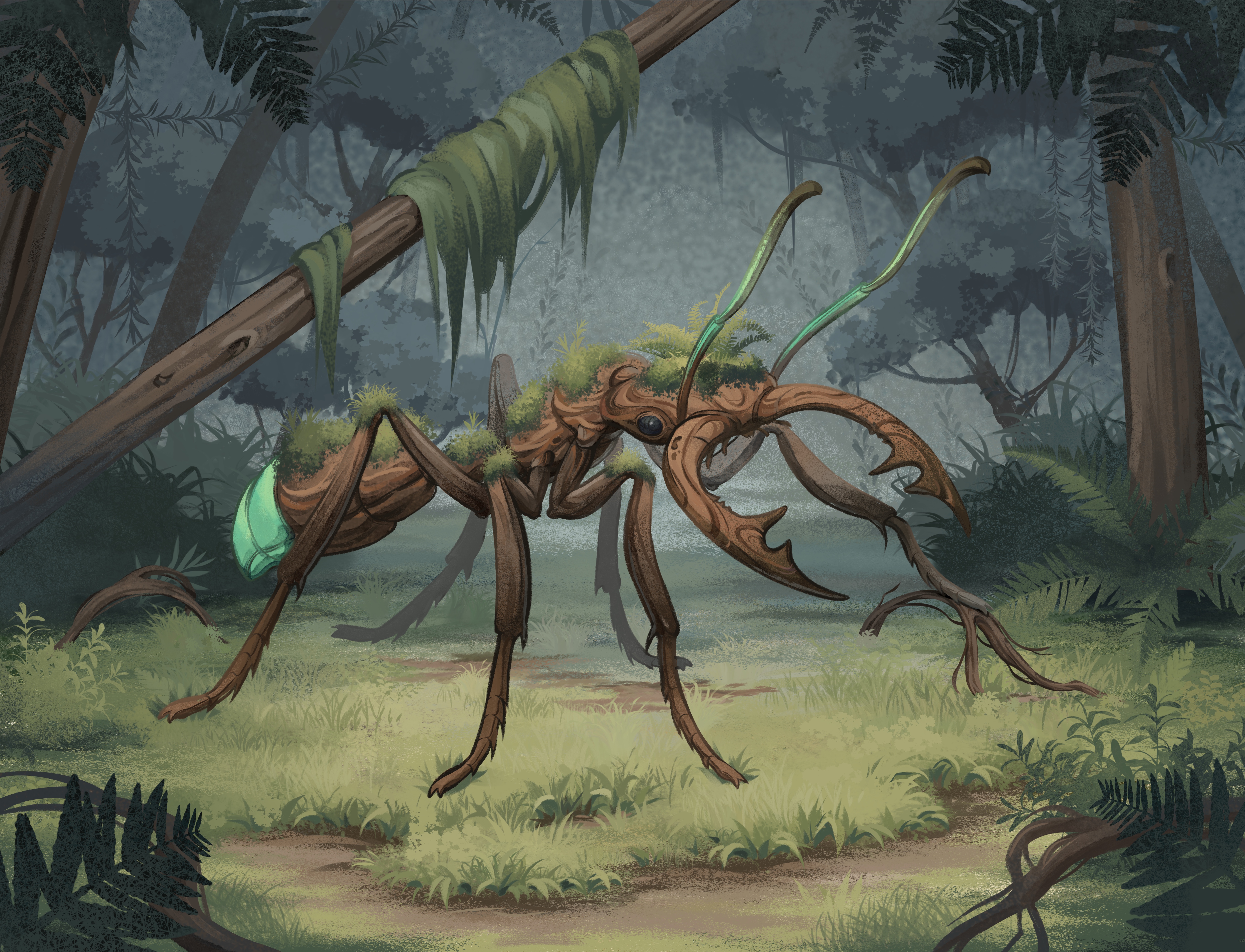Kouko Vallis Titanomyrma
Overview
The Kouko Vallis Titanomyrma (Titanomyrma koukoensis) is a species of giant, socially complex insectoids that function as an ecological apex predator and keystone species within their native habitat. Resembling massive ants of roughly canine proportions, they possess a sophisticated caste structure and engage in complex agricultural and environmental engineering behaviors. Their colonies, which can number in the hundreds of thousands, reshape the very floor of the rainforests they inhabit, existing as a relentless, swarming force of nature.
Physical Description
Anatomy & Appearance
An adult Titanomyrma koukoensis typically measures between 45 to 80 centimeters in length. Their exoskeletons are robust and muscular with a bark-like texture, often covered in symbiotic, epiphytic moss that provides natural camouflage against the rainforest floor. Their coloration is a mixture of dark greens and ochre. Their multifaceted eyes are pronounced, and their antennae are thick, ribboned, and highly mobile, appearing almost translucent with a greenish tint. Along their ventral plates are visible slit-like pores, which are sternal glands used for exuding complex chemical signals.
Caste Dimorphism
The species exhibits significant physical variation based on caste roles within the colony:
- Workers: Possess sleeker, more flexible bodies adapted for climbing and transport. Their jaws are specialized for carrying plant matter, spores, and soil, and they feature a dorsal pouch for carrying fungal spores for cultivation.
- Soldiers: Heavily armored, particularly around the head, which is enlarged to support massive, slicing mandibles reinforced with silica. The chitin on their mandibles carries a noticeable iridescent sheen.
- Queens: The largest caste, reaching up to 1.5 meters in length. A queen is distinguished by a gigantic, bulbous abdomen with a semi-translucent carapace, through which the glowing tissues of her brood are faintly visible. She is the source of the colony's master pheromonal signal.
Abilities & Traits
Chemical Communication
Communication is achieved through a highly advanced system of pheromones. The hyper-segmented, ribbon-like antennae are densely packed with chemoreceptors capable of detecting dozens of pheromone variants, each corresponding to a specific task, resource, or threat. These signals are supplemented by chemical trails exuded from their sternal glands, which create semi-permanent, iridescent highways across their territory.
Proto-Sentience & Collective Intelligence
Titanomyrma koukoensis displays significant emergent intelligence. Workers possess advanced route memory, allowing them to adapt their chemical trails to bypass new hazards. The colony demonstrates adaptive problem-solving and can "learn" to avoid dangers through shared experience. Major decisions, such as nest relocation, are made through a process of quorum-sensing, where individuals "vote" via pheromone exchanges in large, vibrating gatherings.
Swarm Response
When an alarm pheromone—a sharp, metallic scent—is released, the entire colony mobilizes with terrifying speed and coordination. This swarming behavior is relentlessly aggressive, capable of driving off even the largest predators in the Kouko Vallis Rainforest.
Biological Engineering & Agriculture
The species engages in a form of proto-agriculture.
- Fungal Gardens: Workers actively cultivate specific fungal species in protected gardens, often established within the hollowed-out roots of megaflora or fallen logs. These gardens are meticulously tended and protected from the elements with wax secretions.
- Megaflora Symbiosis: Colonies form a symbiotic relationship with certain Chlorowood saplings. The ants defend the young trees from herbivores and, in return, feed on nutrient-rich sap excreted from specialized nodules on the plant. They may also be observed "herding" smaller insect species to harvest their secretions for larval food.
Habitat & Homeworld
The native and only known habitat of the Titanomyrma koukoensis is the Kouko Vallis Rainforest, located in the Boreas Region of Terra within the Sol System. They are crucial soil engineers, with their vast tunnel networks aerating the soil and enabling rapid regeneration of flora after floods or landslides. Their nest mounds rise from the forest floor like sculpted towers, interlaced with living roots and glowing fungi.
Ecological Interactions & Impact
As a keystone species, the Titanomyrma profoundly shapes its environment. Their foraging habits dictate the patterns of undergrowth, suppressing some plant species while creating opportunities for rare canopy flora to seed. Their presence has forced adaptations in local fauna; the Kouko Tree Ferret, for instance, has an instinctual terror response to their alarm pheromones.
Occasionally, rival supercolonies will engage in massive wars over resources. These conflicts leave swathes of the forest temporarily cleared, followed by a period of uniquely rapid regrowth known as the “Green Pulse.”
History
The Kouko Vallis Titanomyrma is documented as an ecological apex species during the late Uplift Era and the early Pax Sapiens Era. Their activities and influence on the Kouko Vallis Rainforest ecosystem were well-established during this period of significant terrestrial transformation on Terra.



Comments